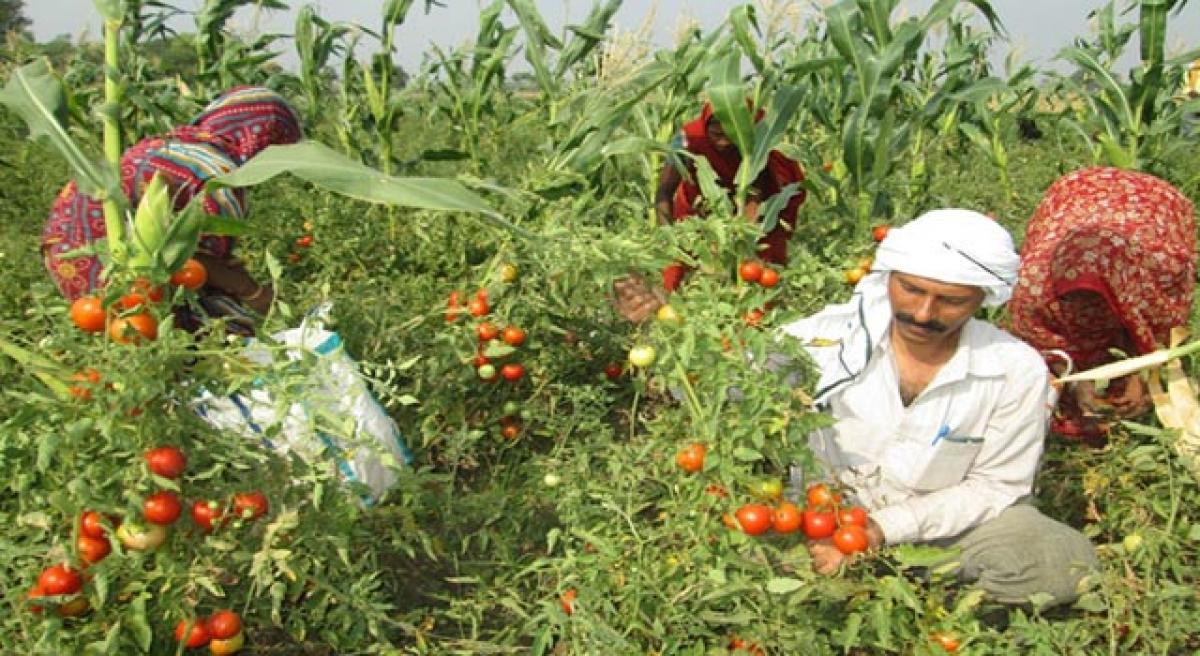Live
- Unleash your creativity with PicLumen's Free AI Art Generator.
- CM Revanth Reddy Congratulates Telangana Athlete Deepti Jeevanji for Arjuna Award Selection
- China adds 10 US companies to unreliable entities list
- Telangana Government Announces January 3 as 'Women Teacher's Day' to Celebrate Savitribai Phule's Legacy
- Mithali Raj Supports AP’s Social Media Kindness Campaign
- Sajad Lone files PIL for fair police verification and rights of citizens
- Global Type 1 diabetes market to reach $9.9 bn by 2033: Report
- Record on New Year’s Eve, KSBCL Records Over Rs. 308 Crore in Liquor Sales
- Software Engineer from Hassan Dies by Suicide
- BJP is Politicising Contractor’s Suicide Case to Target Priyank Kharge- Bhandari
Just In

The Food and Agriculture Organization (FAO), in its report, ‘The Future of Food and Agriculture: Trends and Challenges,’ observes world population would reach 9.73 billion in 2050. In sub-Saharan Africa and South Asia, agricultural output would need to more than double by 2050 to meet the increase in demand.
The Food and Agriculture Organization (FAO), in its report, ‘The Future of Food and Agriculture: Trends and Challenges,’ observes world population would reach 9.73 billion in 2050. In sub-Saharan Africa and South Asia, agricultural output would need to more than double by 2050 to meet the increase in demand.
Despite undeniable progress in reducing rates of undernourishment and improving levels of nutrition and health, almost 800 million people are chronically hungry and 2 billion suffer micronutrient deficiencies. High-input, resource-intensive farming systems, which have caused massive deforestation, water scarcities, soil depletion and high levels of greenhouse gas emissions, cannot deliver sustainable food and agricultural production as per the FAO report.
Innovative systems are needed that protect and enhance the natural resource base, while increasing productivity by focusing on agro-ecology, agro-forestry, climate-smart agriculture and conservation of agriculture, which also build upon indigenous and traditional knowledge. In view of these, the long-term objective of FAO, Organic Agriculture Programme, is to enhance food security, rural development, sustainable livelihoods and environmental integrity by building capacities of member-countries in organic production, processing, certification and marketing.
Incidentally, the Government of Telangana gives topmost priority to ‘Promotion of organic farming to meet the demand for world market’ as mentioned in the Report of Agriculture Action Plan for 2016-17, published by it. The report states, “Agriculture is on the top of the State Government agenda and efforts are being made to increase productivity and areas especially under food grains while ensuring that the income of the farmers goes up.
The envisaged growth in excess of 6% in the Agriculture sector during the 12thplan is possible only if the farm income improves substantially. As an Agriculture and Irrigation Policy Initiatives of the State it is targeted for higher productivity in respect of food crops.” Organic farming has a huge scope in the state of Telangana. The author, based on a field study carried out in March 2017 among the villagers of Nagar Kurnool and Wannaparthy districts, has observed that many have been carrying out the activities.
To popularise organic farming in Telangana, a dynamic youth hailing from Telangana has set up a private limited company namely “Lakshyas Agri Solution.” He was working as software engineer in US, but left the job and started the enterprise after creation of Telangana. Lakshyas’ core objective is to "Enterprise Rural Agriculture,” thus increasing per capita income of marginal and small farmers through organic farming. It seeks to buy farmers’ products by paying a premium and sell them in turn in urban markets. In this process, urban people get chemical-free crops, basically millets.
A few farmers were contacted in first week of March 2017 in Nagar-Kurnool district and Wannaparthy district of earlier Mehbubnagar district. Out of experiences with them, a case is presented here to get an in-depth idea about the organic way of farming. BhaskarGoud, 34, of Gopalapur village in Pentalavalley mandal of Nagar Kurnool district has been undertaking organic farming i.e., using organic fertilisers, organic pesticides and organic micro-nutrients from 2013. He had five acres of which two acres are used for paddy cultivation and three acres are used for groundnut cultivation.
He used ‘Cheppa Vellum’ to enrich agricultural production, ‘Jivaamritam’ as organic fertilisers and ‘Agni astram’ as natural pesticides. For preparing ‘Cheppa Vellum,’ fish-waste, jaggery (in India commonly known as Gur) and water are used. For ‘Jivaamritam,’ water, cow urine, cow dung, jaggery, beson (Bengal gram powder) and little soil are mixed and processed and used as organic fertiliser. In the case of ‘Agni astram,’ cow urine, neem leaves, tobacco leaves, garlic and green chilly are used to make organic pesticide.
The expenditure for utilising organic products for his five acres is a paltry sum of Rs 1,000 but main expenditure is labour costs, use of tractor and seed cost. By cultivating paddy through natural farming in two acres in Kharif, he could earn around Rs 55,000 as net profit, and by cultivating groundnut in three acres, he earned a net profit of Rs 60,000. He says net profit may go up by 50 per cent more if favorable rainfall happens. This case is only a sample one but like him, many farmers have adopted and adapted organic farming.
In the present situation, organic farming offers huge scope for sustainable agriculture development in Telangana and will help realise the government’s objective of ‘Promotion of organic farming to meet the demand for World Market.” The author believes that organic farming will help eliminate agrarian distress, thereby, farmer suicides. (Writer is Former Professor (CPME), NIRD&PR, Hyderabad; The article is an abridged version of the research paper presented at the First Annual Conference of Telangana Economic Association (TEA) held at CESS, Hyderabad, on April 8-9, 2017)
By Dr Shankar Chatterjee

© 2024 Hyderabad Media House Limited/The Hans India. All rights reserved. Powered by hocalwire.com







